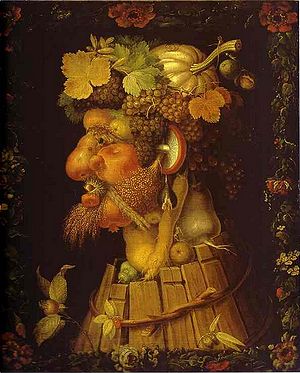Mannerism
 From Conservapedia
From Conservapedia The art term Mannerism derives from the Italian word "maniera" which means "style" or "manner". Giorgio Vasari, a Mannerist architect, painter and art-historical writer, described the period in which he worked as "la maniera moderna". The Mannerist School of painting is a period that follows Renaissance and precedes the Baroque; it is characterized by its intellectual sophistication as well as its artificial qualities. In the 17th century "la maniera" was used as a derogatory term for the decline of art.
Notable Mannerist artist were: Michelangelo (in an extension of his art), Agnolo di Cosimo (Il Bronzino), Giorgio Vasari, the Carracci brothers, Caravaggio, El Greco, Giuseppe Arcimboldo, Francois Clouet and Jean Clouet.
Mannerism was also present in architecture, literature and music.
Giuseppe Arcimboldo, Autumn, 1573.
See also[edit]
Categories: [Artistic Movements] [Painting] [Art]
↧ Download as ZWI file | Last modified: 03/06/2023 07:12:57 | 9 views
☰ Source: https://www.conservapedia.com/Mannerism | License: CC BY-SA 3.0
 ZWI signed:
ZWI signed:
 KSF
KSF